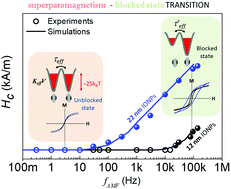Superparamagnetic-blocked state transition under alternating magnetic fields: towards determining the magnetic anisotropy in magnetic suspensions†
Abstract
The potential of magnetic nanoparticles for acting as efficient catalysts, imaging tracers or heating mediators relays on their superparamagnetic behaviour under alternating magnetic fields. In spite of the relevance of this magnetic phenomenon, the identification of specific fingerprints to unequivocally assign superparamagnetic behaviour to nanomaterials is still lacking. Herein, we report on novel experimental and theoretical evidences related to the superparamagnetism observed in magnetic iron oxide nanoparticle suspensions at room temperature. AC magnetization measurements in a broad field frequency range from mHz to kHz and field intensities up to 40 kA m−1 unambiguously demonstrate the transition from superparamagnetic to blocked states at room temperature. Our experimental observations are supported by a theoretical model based on the stochastic Landau–Liftshitz–Gilbert equation. An empirical expression is proposed to determine the effective magnetic anisotropy from the field frequency value beyond which AC magnetization shows hysteretic behaviour. Our results significantly improve the understanding and description of the superparamagnetism of iron oxide nanoparticles, paving the way towards a more efficient exploitation of their unique magnetic properties.



 Please wait while we load your content...
Please wait while we load your content...